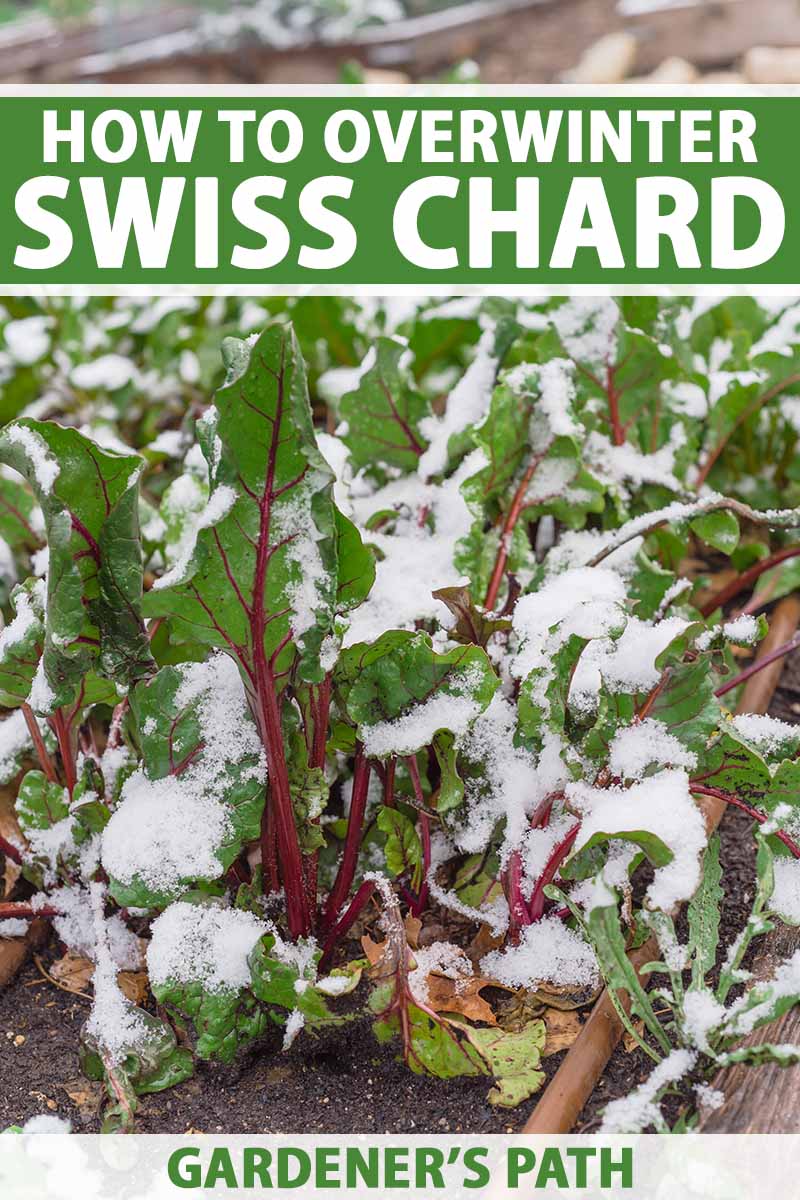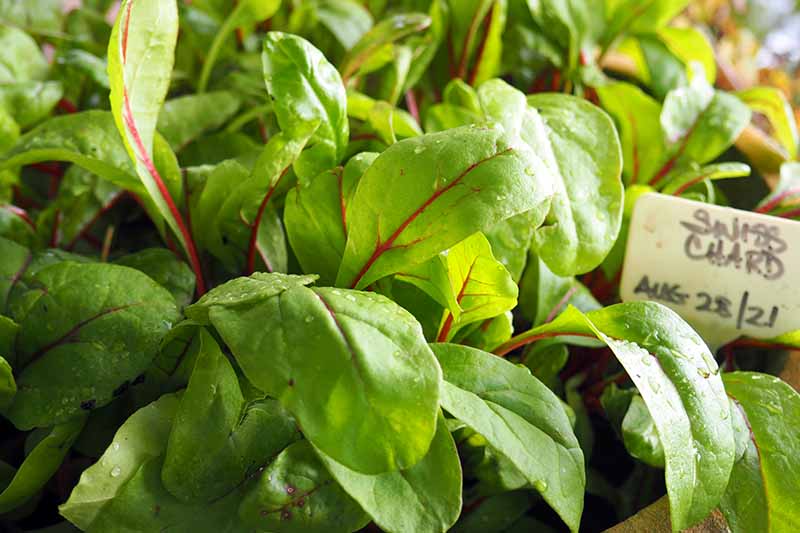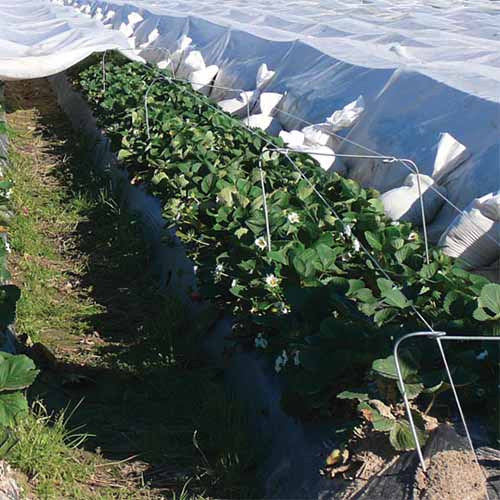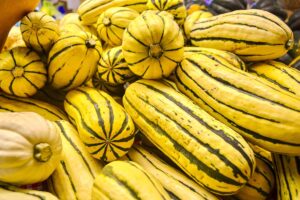Tasty, nutritious, and prolific with beautiful savoyed leaves and crisp, colorful stalks, Swiss chard is a garden stalwart that gives gardeners an extra-long growing season and multiple harvests.
Both heat and cold tolerant, it thrives in the cool temperatures of spring and fall, but it’s also productive during the hot months of summer – only slowing down a bit when temperatures rise into the mid-80s and above.
Moderately cold hardy, flavors improve with a touch of frost, and plants can handle temperatures as low as 15°F.
This means they’re readily overwintered if you’re in a sweet spot of mild or cool – but not too cold – winters.

We link to vendors to help you find relevant products. If you buy from one of our links, we may earn a commission.
Growth slows to a crawl, or even a standstill in the coldest and darkest months of December through February.
But once daylight hours begin to lengthen, new growth emerges with vigor, and leaves can be harvested again beginning in March – with plants that are every bit as vigorous in their second growing season as their first before they bolt and set seed.
The ultimate in crop convenience, you can plant once and harvest for two growing seasons!
If you like your leafy greens early and easy, get comfy and learn how to overwinter cold-hardy Swiss chard.
Here’s what’s ahead:
What You’ll Learn
Bountiful Biennials
A member of the beet family, Swiss chard (Beta vulgaris) is a biennial that sets seed in its second year of growth.

This highly nutritious leafy green is most often grown as an annual, with plants sown in early spring and removed from the vegetable beds in fall.
However, this productive veg is also very easy to overwinter and responds with a second season of productive growth – given the right conditions.
A touch of frost actually improves the taste, because the cold causes leaves to lose their bitter tones, revealing a milder, sweeter flavor.

Swiss chard can survive temperatures down to 15°F, or the winter climate of USDA Hardiness Zone 8.
Overwintering in warmer regions of Zone 7 is possible, provided plants are heavily mulched and located in a protected site.
And container-grown plants are another good option for overwintering in colder regions.
Reasonably sized pots and containers can be moved under shelter or snuggled into nooks and crannies against fences, foundations, and shrubbery for protection and extra warmth, effectively improving their ability to withstand the cold.
Planting for Winter
In cultivation, Swiss chard is added to the winter garden with either early or late crops.
Early-Sown Crops
Early crops are planted in spring and harvested throughout spring, summer, and fall.

The established plants are then left in place over winter and go semi-dormant, with little or no growth.
But once daylight hours begin to increase around mid-February, new growth emerges rapidly, making chard one of the earliest of the leafy greens to harvest from the garden.
New leaves grow quickly, and baby greens can be picked in two to four weeks’ time.
Or they can be left to grow larger, with mature leaves ready for harvest about 35 days after new growth begins.
Plants then provide a steady supply of leaves until they bolt and finish their lives after flowering and setting seed in their second season.
Lift and discard plants when they bolt, or allow a few plants to finish their cycle and harvest your own seeds in late summer to early fall.
Late-Sown Crops
A late crop is planted towards the end of the growing season, typically throughout August and early September.

But with late crops, it’s important that plants have adequate time to develop a strong, healthy root system before cold weather arrives. As such, seeds must be sown at least four to six weeks prior to the first expected frost date.
Late crops provide young, tender leaves about 30 days after sowing and can be harvested through fall.
Overwintered late crops are ready for harvest again early the following spring after new growth begins, and provide a steady supply of leaves through spring, summer, and fall.
Should late crops bolt in summer, cut the stems close to the base and leafing will continue. Dig up late crops in their second fall season.
For maximum convenience and productivity, plant successive early, mid-season, and late crops in one year and enjoy a perpetual harvest for two growing seasons without resowing – that’s crop efficiency at its best!
Provide Cover in the Coldest Months
Swiss chard can easily withstand several light frosts without protection, and flavors sweeten when they’ve been kissed by cold temperatures.
But they’ll also benefit from some protection throughout the coldest months of winter.

A blanket of snow provides good insulation, but if it isn’t consistent, roots can be exposed to freeze and thaw cycles, reducing their chance of survival.
A more reliable method is to provide a thick, four-inch mulch of leaves or straw around and between plants to insulate the dormant roots.
A floating row cover can also provide protection against the elements and can be used in garden beds or with containers. Agribon 50 covers offer a high level of protection.
These are available in various sizes at Arbico Organics.
If needed, provide extra protection for container plants with a two- to four-inch layer of leaf or straw mulch, and/or a floating row cover.
What to Do After Overwintering
When growth resumes in spring, remove winter mulches and hoe lightly between plants to loosen the topsoil, taking care not to disturb the roots.
In early spring, apply a top-dressing of aged compost or manure around and between the plants to enrich the soil. A water-soluble all-purpose 10-10-10 (NPK) fertilizer can be applied in early summer if needed.
All of the necessary cultivation details can be found in our guide on how to plant and grow Swiss chard.
A Hefty Harvest
One of the easiest, most nutritionally dense, and most productive crops in the veggie patch, Swiss chard readily overwinters in Zones 8 through 11.

Remember to mulch the roots or add a floating row cover for protection. And tuck containers into protected areas if needed.
Once spring arrives again, kick back and enjoy a hefty harvest without planting a single seed!
Do you folks have any favorite overwintering tips or questions? Let us know in the comments section below.
And to learn more about growing Swiss chard in your garden, add these articles to your reading list next:



